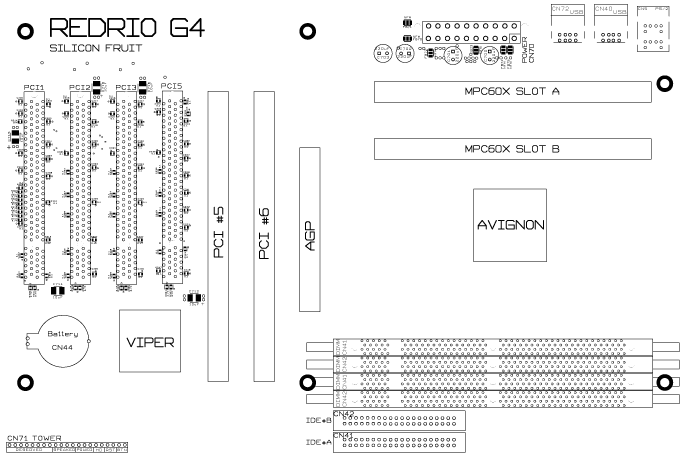You may also notice
that the processors are used in a slot format, which are indeed Slot 1, but with
different pinouts. However, the power and ground pins will be the same to prevent
someone from damaging any x86 CPUs mistakenly put on the motherboard.
Silicon Fruit plans
on shipping 50 boards out to developers in the first quarter of 2000, and then
have a first production run of about 2,000. In the late second quarter, at the
earliest, the RioRed motherboard will be shipping inside a workstation tentatively
entitled the Metanium.
The
Metanium workstation will be a very fresh workstation product with a lot of interesting
new features. One example is the use of an LCD display on the tower that a person
can use to see what is happening when the machine boots, and view in clear text
what is wrong if problems arise, rather than relying on beep codes. It will also
continuously display the uptime, CPU usage and temperature. For the over-clocking
folks, there is even a function for automatically reducing clock speed it the
CPU gets too hot. The workstation is also likely to ship with a Digital Signal
Processor add-in card (also in development by Silicon Fruit) for very high-end
multimedia processing.
Initially,
Silicon Fruit will have a VA Linux-like business agenda, but also plans to sell
boards to other Linux assemblers. The motherboards will ship with a copy of Yellow
Dog Linux tuned for the RioRed.
Silicon
Fruit is also making motions in an attempt to get the BeOS to run on its platform,
as the OS would run very well on double G4 processors, and could work very well
with the multimedia-enhanced AltiVec processing extensions.
Initial pricing for systems
based on the RioRed should fall somewhere between the cost of a high-end PC and
a dual G4 Power Mac, should they be released. Considering the power of the G4
processor, the RioRed will make a great foundation for an extremely powerful,
yet low priced workstation.
Silicon
Fruitís new platform may also be great for custom applications, as they are working
with Berkeley University to make an advanced server cluster running highly processor
intensive software applications.
Only
time will tell if this second attempt at creating an open PowerPC platform will
succeed. Considering the credentials of the PowerPC processor, and the openness
of the Linux community, there should be room for Silicon Fruit to grow and succeed.
At the very least, Silicon Fruit has potential in vertical applications.

Supplementary
Links:
